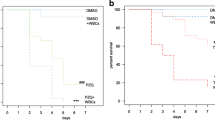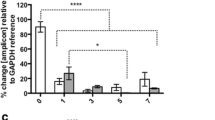Abstract
The present study describes the effects of the H+ ionophore and anthelmintic closantel upon the in vitro motility and in vivo ultrastructure of the liver fluke,Fasciola hepatica. At a concentration of 50 μg/ml, closantel caused an initial stimulation, then suppression of activity, which was accompanied by an increase in muscle tone and led to a spastic paralysis within 2 h. The pattern of response was similar at lower concentrations, although the initial stimulation was not always evident, but the onset of paralysis could be reached more quickly. Scanning electron microscopy revealed gross surface damage from 24 h onwards in vivo, in the form of erosion of the anterior and posterior extremities of the fluke and large-scale sloughing of the tegument on both dorsal and ventral surfaces. Tegumental changes prior to sloughing included some swelling of the basal infolds and an apical accumulation of T1 secretory bodies. In the underlying tegumental cells there was reduced secretory activity and the mitochondria were consistently swollen and deformed. Reduced secretory activity was a feature of the gastrodermal cells as well; these cells were characterized by swollen, electron-lucent mitochondria, vesiculated GER cisternae and apical blebbing of packets of cytoplasm. The vitelline follicles became severely disrupted as a result of the breakdown of the nurse cell cytoplasm. The stem and intermediate type 1 (It1) cells rounded up and showed nuclear abnormalities. There did not appear to be a severe disruption of shell protein production in the intermediate vitelline cells, but there was a noticeable absence of glycogen in the mature vitelline cells. The effects of closantel are discussed in relation to its proposed mode of action as an uncoupler of oxidative phosphorylation.
Similar content being viewed by others
References
Barrett J (1976) Bioenergetics in helminths. In: Van den Bossche H (ed) Biochemistry of parasites and host-parasite relationships. Elsevier/North Holland Biomedical Press, Amsterdam New York Oxford, pp 67–80
Barrett J (1981) Biochemistry of parasitic helminths. Macmillan & Co., London
Bennett CE, Hughes DL, Harness E (1980)Fasciola hepatica: changes in tegument during killing of adult flukes surgically transferred to sensitized rats. Parasite Immunol 2:39–55
Bryant C, Cornish RA, Rahman MS (1976) Adenine nucleotides as indicators of anthelmintic efficacy. In: Van den Bossche (ed) Biochemistry of parasites and host-parasite relationships. Elsevier/North Holland Biomedical Press, Amsterdam New York Oxford, pp 599–604
Bygrave FL (1978) Mitochondria and the control of intracellular calcium. Biol Rev 53:43–79
Corbett JR (1974) The biochemical mode of action of pesticides. Academic Press, London
Corbett JR, Goose J (1971) A possible biochemical mode of action of the fasciolicides nitroxynil, hexachlorophene and oxyclozanide. Pestic Sci 2:119–121
Cornish RA, Bryant C (1976) Changes in energy metabolism due to anthelmintics inFasciola hepatica maintained in vitro. Int J Parasitol 6:393–398
Fairweather I, Holmes SD, Threadgold LT (1983)Fasciola hepatica: a technique for monitoring in vitro motility. Exp Parasitol 56:369–380
Fairweather I, Holmes SD, Threadgold LT (1984)Fasciola hepatica: motility response to fasciolicides in vitro. Exp Parasitol 57:209–224
Fairweather I, Anderson HR, Threadgold LT (1986)Fasciola hepatica: tegumental changes induced in vitro by the deacetylated (amine) metabolite of diamphenethide. Exp Parasitol 62:336–348
Fairweather I, Skuce PJ, Holmes SD (1988) Diamphenethide — a reassessment of its pharmacological action. Parasitol Res 74:456–462
Fini G, Pasquali-Ronchetti I (1981) Raman spectroscopic investigations on conformational changes induced by some phenol derivatives on phospholipid membranes. Membrane Biochem 4:119–128
Hanna REB (1980)Fasciola hepatica: an immunofluorescent study of antigenic changes in the tegument during development in the rat and sheep. Exp Parasitol 50:155–170
Heytler PG (1979) Uncouplers of oxidative phosphorylation. Methods Enzymol 55:462–472
Holmes SD, Fairweather I (1984)Fasciola hepatica: the effects of neuropharmacological agents upon in vitro motility. Exp Parasitol 58:194–208
Holmes SD, Fairweather I (1985)Fasciola hepatica: motility response to metabolic inhibitors in vitro. Exp Parasitol 59:275–289
Isseroff H, Read CP (1969) Studies on membrane transport: VI. Absorption of amino acids by fascioliid trematodes. Comp Biochem Physiol 30:1153–1160
Isseroff H, Read CP (1974) Studies on membrane transport: VIII. Absorption of monosaccharides byFasciola hepatica. Comp Biochem Physiol [A] 47:141–152
Kaila K (1982) Cellular neurophysiological effects of phenol derivatives. Comp Biochem Physiol [C] 73:231–241
Kaila K, Saarikoski J (1981) Membrane-potential changes caused by 2,4-DNP and related phenols in resting crayfish axons are not due to uncoupling of mitochrondia. Comp Biochem Physiol [C] 69:235–242
Kane HA, Behm CA, Bryant C (1980) Metabolic studies on the new fasciolicidal drug, closantel. Mol Biochem Parasitol 1:347–355
Kessler RJ, Tyson CA, Green DE (1976) Mechanism of uncoupling in mitochondria: uncouplers as ionophores for cycling cations and protons. Proc Natl Acad Sci USA 13:3141–3145
Ledger PW, Tanzer ML (1984) Monensin — a perturbant of cellular physiology. TIBS 9:313–314
Lloyd GM (1986) Energy metabolism and its regulation in the adult liver flukeFasciola hepatica. Parasitology 93:217–248
Lloyd GM, Barrett J (1983)Fasciola hepatica: carbohydrate metabolism of the adult. Exp Parasitol 56:81–88
Mitchell P (1961) Coupling of phosphorylation to electron and hydrogen transfer by a chemi-osmotic type of mechanism. Nature 191:144–148
Robinson G, Threadgold LT (1975) Electron microscope studies ofFasciola hepatica: XII. The fine structure of the gastrodermis. Exp Parasitol 37:20–36
Rogan MT, Threadgold LT (1984)Fasciola hepatica: tegumental alterations as a consequence of lectin binding. Exp Parasitol 57:248–260
Saris N-E, Åkerman KEO (1980) Uptake and release of bivalent cations in mitochondria. Curr Top Bioenerg 10:103–179
Schulman MD, Valentino D (1980)Fasciola hepatica: effect of 4-amino-6-trichloroethenyl-1,3-benzenedisulphonamide on glycolysis in vitro. Exp Parasitol 49:206–215
Skuce PJ (1987) The effects of selected ionophores upon the pharmacology and ultrastructure of the liver flukeFasciola hepatica. PhD Thesis, The Queen's University of Belfast
Skuce PJ, Fairweather I (1988a)Fasciola hepatica: perturbation of secretory activity in the vitelline cells by the sodium ionophore monensin. Exp Parasitol 65:20–30
Skuce PJ, Fairweather I (1988b) The effect of the H+ ionophore closantel upon adultFasciola hepatica. In: Proceedings of the British Society for Parasitology, Spring Meeting held at the University of Reading, March 1988, p 40
Skuce PJ, Fairweather I (1988c)Fasciola hepatica: the effect of the sodium ionophore monensin on the adult tegument. Parasitol Res 15:223–232
Spurr AR (1969) A low-viscosity epoxy resin embedding medium for electron microscopy. J Ultrastruct Res 26:31–43
Tartakoff AM (1983) Perturbation of vesicular traffic with the carboxylic ionophore monensin. Cell 32:1026–1028
Threadgold LT (1985)Fasciola hepatica: interaction of the tegument with poly-l-lysine and enzymes. Exp Parasitol 59:222–230
Threadgold LT, Brennan G (1978)Fasciola hepatica: basal infolds and associated vacuoles of the tegument. Exp Parasitol 46:300–316
Tielens AGM, Van den Heuvel JM, Van den Bergh SG (1982) Changes in energy metabolism of the juvenileFasciola hepatica during its development in the liver parenchyma. Mol Biochem Parasitol 6:277–286
Tielens AGM, Van den Heuvel JM, Van den Bergh SG (1984) The energy metabolism ofFasciola hepatica during its development in the final host. Mol Biochem Parasitol 13:301–307
Trump BF, Berezesky IK, Osornio-Vargas AR (1981) Cell death and the disease process — the role of calcium. In: Bowen ID, Lockshin RA (ed) Cell death in biology and pathology. Chapman and Hall, London/New York, pp 209–242
Van den Bergh SG, Van Vugt F, Tielens AGM (1980) Anaerobic and aerobic energy metabolism of the common liver flukeFasciola hepatica. In: Vitale L, Simeon V (eds) Industrial and clinical enzymology. Pergamon Press Ltd., Oxford, pp 231–242 (FEBS Symposia, vol 61)
Van den Bossche H (1976) The molecular basis of anthelmintic action. In: Van den Bossche H (ed) Biochemistry of parasites and host-parasite relationships. Elsevier/North Holland Biomedical Press, Amsterdam, pp 553–572
Van den Bossche H (1985a) How anthelmintics help us to understand helminths. Parasitology 90:675–685
Van den Bossche H (1985b) Pharmacology of anthelmintics. In: Van den Bossche H, Thienpont D, Janssen PG (eds) Chemotherapy of gastrointestinal helminths. Handb Exp Pharmacol 77:125–181
Van den Bossche H, Verhoeven H (1982) Biochemical effects of the antiparasitic drug closantel. In: Proceedings of the British Society for Parasitology, Spring meeting held at Noordwijkerhout, The netherlands, April 1981/Parasitology 84:1i
Van den Bossche H, Verhoeven H, Vanparijs O, Lauwers H, Thienpont D (1979) Closantel, a new antiparasitic hydrogen ionophore. Arch Int Physiol Biochim 87:851–852
Van Miert ASJPM, Groeneveld HW (1969) Anthelmintics, used for the treatment of fascioliasis, as uncouplers of oxidative phosphorylation in warm blooded animals. Eur J Pharmacol 8:385–388
Van Vugt F (1979/80) The energy metabolism of the adult common liver fluke,Fasciola hepatica. Vet Sci Commun 3:299–316
Vasington FD, Murphy JV (1962) Ca2+ uptake by rat kidney mitochondria and its dependence on respiration and phosphorylation. J Biol Chem 237:2670–2677
Veenendaal GH, Waal MJ de (1974) Uncoupling activity of the anthelmintic oxyclozanide in rodents. Br J Pharmacol 50:435–437
Verheyen A, Borgers M, Van den Bossche H, Vanparijs O, Lauwers H, Thienpont D (1979) The localization of mitochondrial ATPase in the different tissues of the mature liver flukeFasciola hepatica L. The influence of in vivo administration of closantel, a new antiparasitic hydrogen-ionophore. Biol Cell 35:36a
Verheyen A, Vanparijs O, Lauwers H, Thienpont D (1980) The influence of closantel administration to sheep on the ultrastructure of the adult liver flukeFasciola hepatica L. In: Van den Bossche H (ed) The host invader interplay. Elsevier/North Holland Biomedical Press, Amsterdam New York Oxford, pp 705–708
Yorke RE, Turton JA (1974) Effects of fasciolicidal and anticestode agents on the respiration of isolatedHymenolepis diminuta mitochondria. Z Parasitenkd 45:1–10
Zhang F, Schneider DL (1983) The bioenergetics of Golgi apparatus function: evidence for an ATP-dependent proton pump. Biochem Biophys Res Commun 114:620–625
Zimmer G (1977) Carbonylcyanide p-trifluoromethoxyphenyl-hydrazone-induced change of mitochondrial membrane structure revealed by lipid and protein spin labelling. Arch Biochem Biophys 181:26–32
Author information
Authors and Affiliations
Rights and permissions
About this article
Cite this article
Skuce, P.J., Fairweather, I. The effect of the hydrogen ionophore closantel upon the pharmacology and ultrastructure of the adult liver flukeFasciola hepatica . Parasitol Res 76, 241–250 (1990). https://doi.org/10.1007/BF00930821
Accepted:
Issue Date:
DOI: https://doi.org/10.1007/BF00930821




